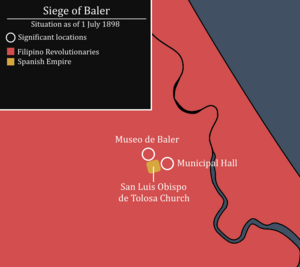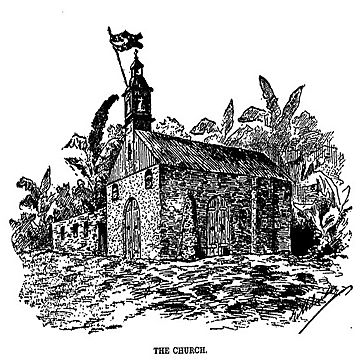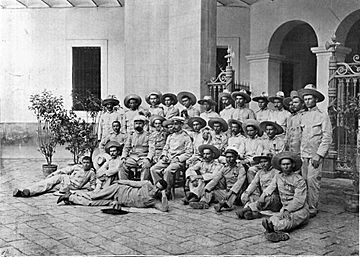Siege of Baler facts for kids
Quick facts for kids Siege of Baler |
|||||||
|---|---|---|---|---|---|---|---|
| Part of the Philippine Revolution | |||||||
 Troops of Colonel Tecson in May 1899 |
|||||||
|
|||||||
| Belligerents | |||||||
|
1898–1899 1899 |
1898–1899 |
||||||
| Commanders and leaders | |||||||
|
|
||||||
| Strength | |||||||
| 800 | ±50 | ||||||
| Casualties and losses | |||||||
| not defined | 17 killed | ||||||
The Siege of Baler was a long battle during the Philippine Revolution. Filipino fighters surrounded a church in Baler, Philippines. Spanish soldiers defended the church for 337 days. This siege lasted from July 1, 1898, to June 2, 1899.
The main war officially ended on December 10, 1898. Spain gave up its control over the Philippines to the United States. But the Spanish soldiers in Baler did not know this. They kept fighting against the Filipino forces until 1899.
Contents
What Led to the Siege?
Baler is a town on the eastern coast of Luzon island. It is about 225 kilometers (140 miles) from Manila. The Philippine Revolution against Spanish rule began in 1896. Spain sent soldiers to Baler to stop Emilio Aguinaldo from getting weapons.
In October 1897, Filipino fighters attacked the Spanish soldiers. They killed some soldiers and captured rifles. The first part of the revolution ended with a peace agreement in 1897.
Baler's Location and Importance
By 1898, the Philippine Revolution started again. Baler was hard to reach. People could only get there by ship or by walking through thick jungles. These jungle paths often washed away in heavy rains.
During this time, the Philippines was also involved in the Spanish–American War. Filipino rebels worked with American forces. This partnership ended when the Philippine–American War began in 1899.
Preparing for Battle
Baler had 50 Spanish soldiers. Captain Enrique de las Morenas led them. On June 1, 1898, Captain Las Morenas began to prepare. He dug a well and gathered food and ammunition. He also made the San Luís de Tolosa church stronger. This church was the only stone building in the area.
The Long Siege Begins
On June 26, 1898, people in Baler started leaving town. The next day, Filipino troops surrounded the city. On the night of June 30, about 800 Filipino soldiers attacked. The Spanish soldiers moved into the church for safety. The town priest, Candido Gómez Carreño, also stayed in the church.
Early Days of the Siege
In the first days, the Filipinos tried to make the Spanish surrender. They left letters and dug trenches around the church. On July 8, the Filipino commander, Cirilo Gómez Ortiz, offered a break in fighting. The Spanish accepted this. On July 18, Calixto Villacorta took command of the Filipino forces. He also sent a warning letter, but the Spanish refused to give up.
Life Inside the Church
The Spanish soldiers were stuck in a small, hot, and humid space. Their food supplies slowly ran out. Enemy gunfire caused some injuries. But diseases like beriberi (a vitamin deficiency), dysentery (a severe stomach illness), and fevers caused more deaths. The first Spaniard to die was the priest, Gómez Carreño.
In September, Lieutenant Alonso was killed. In November, Captain Las Morenas died from beriberi. Lieutenant Saturnino Martín Cerezo then took command. The Spanish soldiers sometimes left the church to burn nearby houses. This stopped the Filipinos from using the houses for cover. The Filipinos tried to smoke out the Spanish by setting fires near the church wall. But the Spanish fought them off and took their wood.
Running Low on Supplies
When the siege started, the Spanish had flour, rice, beans, meat, and other foods. But they had no salt. To get more food, they looked for pumpkins, oranges, and herbs. They also planted a small garden with peppers, tomatoes, and pumpkins.
By mid-November, the Filipinos had not forced the Spanish to surrender. Villacorta, the Filipino commander, left newspapers on the church steps. These papers said that Spain was leaving the Philippines. They also said the Spanish–American War was over. Martín Cerezo thought this was a trick. Villacorta even brought Spanish civilians and an officer to convince them, but it did not work.
The Siege Continues
By November 22, 145 days had passed since the siege began. Fourteen Spanish soldiers had died from disease. Only 23 of the 38 remaining soldiers were healthy enough to fight. The Filipinos also had losses, mostly from Spanish rifle fire. Gómez Ortiz, a Filipino commander, was one of those killed.
In the new year, more Spanish messengers came to Baler. But Martín Cerezo still refused to surrender. In late February, the Spanish killed three water buffaloes. They ate the meat and used the leather for shoes.
American Involvement
The Treaty of Paris officially ended the war between Spain and the U.S. in December. In April, the Americans tried to help the Spanish. Commander Charles S. Sperry of the USS Yorktown tried to rescue them. By this time, Filipino rebels had declared independence. They had been fighting the United States for two months.
Five Americans on a scouting mission were killed. Lieutenant James Clarkson Gilmore and nine others were captured. They were held by the Filipinos until December. When the Spanish soldiers' food ran out on April 24, they ate stray dogs, cats, reptiles, snails, and crows. On May 8, Filipino artillery hit a makeshift prison. Three Spanish soldiers who had tried to desert earlier were held there. One of them, Alcaide Bayona, ran out and joined the Filipinos. This was a big problem for the Spanish. The deserter knew how desperate their situation was. He helped the Filipinos fire cannons at the church.
The Final Surrender
On May 28, 1899, there was another attempt to make Martín Cerezo surrender. Another Spanish officer, Lieutenant Colonel Cristóbal Aguilar y Castañeda, came under a flag of truce. Martín Cerezo turned him away. But the officer had brought recent Spanish newspapers. Cerezo first thought they were fake. Then he read an article about a close friend's new job. Only he knew about these plans. This convinced him the newspapers were real. He finally understood that Spain had lost the war. On June 2, Martín Cerezo surrendered to the Filipinos.
What Happened After?
General Emilio Aguinaldo, the president of the First Philippine Republic, made a special order. He said the Spanish soldiers should not be treated as prisoners of war. Instead, they should be treated as friends. He praised their bravery and how they defended their flag for almost a year. He called it an "epic so glorious."
Three months later, on September 1, the survivors arrived in Barcelona, Spain. They were welcomed as heroes. Martín Cerezo later wrote a book about the siege. He explained that he held out because of trust issues and stubbornness. He also felt a strong sense of national pride and a desire for glory.
Fate of Others
Two priests, Félix Minaya and Juan López, and an American sailor named George Arthur Venville, were held by the Filipino commander Novicio. The priests were rescued by Americans in June 1900. However, Venville was killed by Ilongots before the Americans arrived. Novicio faced serious charges for his actions against the American sailor Ora B. McDonald. He was found guilty and sentenced to life in prison.
Honoring the Heroes
Captain Las Morenas was promoted to major after his death. He received Spain's highest military medal. His wife received a pension. Martín Cerezo was also promoted to major and received a pension. He was given a high military honor and later became a brigadier general. He died in 1945. Lieutenant Zayas was promoted after his death too. The regular soldiers received military medals and monthly pensions.
Out of the 50 men who entered the church, about 30 survived the 11-month siege. Fourteen men died from disease. Only two died from wounds. Four men tried to desert. Two men were executed for helping a deserter, just before the surrender. The bravery of the Spanish soldiers impressed American General Frederick Funston. He had Martín Cerezo's book translated for all his officers. The survivors were known as "the last ones of the Philippines." A hundred years later, the Spanish government honored them.
The Siege in Movies
The Siege of Baler has been shown in several films:
- The 1945 Spanish film Los últimos de Filipinas
- The 2008 Filipino film Baler
- The 2016 Spanish film 1898, Our Last Men in the Philippines
It also appeared in a two-part episode of the Spanish TV show El Ministerio del Tiempo.
See also
 In Spanish: Sitio de Baler para niños
In Spanish: Sitio de Baler para niños




